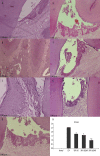Effects of systemic ornidazole, systemic and local compound ornidazole and pefloxacin mesylate on experimental periodontitis in rats
- PMID: 22367122
- PMCID: PMC3560749
- DOI: 10.12659/msm.882514
Effects of systemic ornidazole, systemic and local compound ornidazole and pefloxacin mesylate on experimental periodontitis in rats
Abstract
Background: The purpose of the current study is to evaluate the effects of systemic ornidazole (SO) and systemic and local compound ornidazole and pefloxacin mesylate (SCOPM/LCOMP) on the inflammatory response associated with rat experimental chronic periodontitis (ECP) in sites with subgingival debridement.
Material/methods: Periodontitis was induced in male Sprague-Dawley rats by placing a thin steel ligature around the upper first molars and inoculating them with Porphyromonas gingivalis 381. After the successful induction of the rat ECP, the periodontitis rats were randomly divided into 3 different combined treatment groups: (A) SO with scaling and root planing (SRP); (B) SCOMP with SRP; and (C) LCOMP with SRP. After 2 weeks the effects of the treatments were evaluated based on gingivitis, plaque index, probing pocket depth, aspartate aminotransferase, alveolar bone loss, and hematoxylin-eosin staining of the region around the first molars.
Results: After treatment, comparison with ECP was performed. The mean percentage reductions of SBI in SO, SCOPM, and LCOPM were 27.73%, 33.61%, and 58.82%, respectively. Those of PI were 33.20%, 42.80%, and 60.00%; those of PPD were 48.66%, 55.70%, and 72.48%; those of GCF-AST were 41.64%, 49.03%, and 66.42%; and those of ABL were 41.19%, 43.63%, and 54.47%, respectively. The inflammatory score of H&E showed median scores of 2.5, 1.75, 1.63, and 0.95 for ECP, SO, SCOMP, and LCOMP, respectively. All 3 treatment groups exhibited significantly reduced inflammation indicators (P<0.05). Of the 3, group C was the most effective (P<0.05).
Conclusions: Although all the combined treatment groups responded to therapy with significant resolution of the infection, adjunctive LCOMP therapy is more effective for periodontitis.
Figures



Similar articles
-
The clinical and microbiological effects of systemic ornidazole in sites with and without subgingival debridement in early-onset periodontitis patients.J Periodontol. 2000 Dec;71(12):1862-73. doi: 10.1902/jop.2000.71.12.1862. J Periodontol. 2000. PMID: 11156043
-
Systemic ornidazole as an adjunct to non-surgical periodontal therapy in the treatment of chronic periodontitis: a randomized, double-masked, placebo-controlled clinical trial.J Periodontol. 2012 Sep;83(9):1149-54. doi: 10.1902/jop.2012.110560. Epub 2012 Jan 5. J Periodontol. 2012. PMID: 22220772 Clinical Trial.
-
A 2-step non-surgical procedure and systemic antibiotics in the treatment of rapidly progressive periodontitis.J Periodontol. 2001 Mar;72(3):275-83. doi: 10.1902/jop.2001.72.3.275. J Periodontol. 2001. PMID: 11327054 Clinical Trial.
-
Antibiotic resistance profile of the subgingival microbiota following systemic or local tetracycline therapy.J Clin Periodontol. 2004 Jun;31(6):420-7. doi: 10.1111/j.1600-051X.2004.00493.x. J Clin Periodontol. 2004. PMID: 15142209 Clinical Trial.
-
[Ornidazole (Tiberal) in periodontal therapy].SSO Schweiz Monatsschr Zahnheilkd. 1983 Oct;93(10):991-1001. SSO Schweiz Monatsschr Zahnheilkd. 1983. PMID: 6359410 Review. German. No abstract available.
Cited by
-
A novel Nanoformulation Development of Eugenol and their treatment in inflammation and periodontitis.Saudi Pharm J. 2019 Sep;27(6):778-790. doi: 10.1016/j.jsps.2019.04.014. Epub 2019 Apr 29. Saudi Pharm J. 2019. PMID: 31516320 Free PMC article.
-
Evaluation of the efficacy of 2% Ocimum sanctum gel in the treatment of experimental periodontitis.Int J Pharm Investig. 2015 Jan-Mar;5(1):35-42. doi: 10.4103/2230-973X.147231. Int J Pharm Investig. 2015. PMID: 25599031 Free PMC article.
-
Decrease of Pericytes is Associated With Liver Disease Caused by Ligature-Induced Periodontitis in Rats.J Periodontol. 2017 Feb;88(2):e49-e57. doi: 10.1902/jop.2016.160392. Epub 2016 Sep 26. J Periodontol. 2017. PMID: 27666673 Free PMC article.
-
Evaluation of the efficacy of Hylotelephium purpureum gel in the treatment of experimental periodontitis.Biomed Rep. 2018 Apr;8(4):378-384. doi: 10.3892/br.2018.1065. Epub 2018 Feb 14. Biomed Rep. 2018. PMID: 29541459 Free PMC article.
-
Induced Periodontitis in Rats With Three Ligature Types: An Exploratory Study.Clin Exp Dent Res. 2024 Aug;10(4):e946. doi: 10.1002/cre2.946. Clin Exp Dent Res. 2024. PMID: 39104140 Free PMC article.
References
-
- Sanz M, Lau L, Herrera D, et al. Methods of detection of Actinobacillus actinomycetemcomitans, Porphyromonas gingivalis and Tannerella forsythensis in periodontal microbiology, with special emphasis on advanced molecular techniques: a review. J Clin Periodontol. 2004;31(12):1034–47. - PubMed
-
- Fujii R, Saito Y, Tokura Y, et al. Characterization of bacterial flora in persistent apical periodontitis lesions. Oral Microbiol Immunol. 2009;24(6):502–5. - PubMed
-
- Haffajee AD, Socransky SS. Relationship of cigarette smoking to the subgingival microbiota. J Clin Periodontol. 2001;28(5):377–88. - PubMed
-
- von Troil B, Needleman I, Sanz M. A systematic review of the prevalence of root sensitivity following periodontal therapy. J Clin Periodontol. 2002;29(Suppl 3):173–77. discussion 195–96. - PubMed
Publication types
MeSH terms
Substances
LinkOut - more resources
Full Text Sources
Other Literature Sources
Research Materials
Miscellaneous

